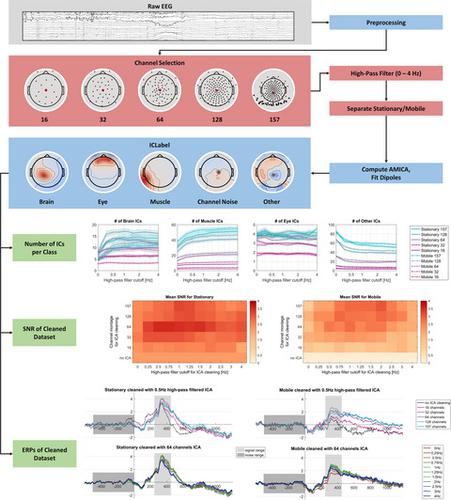当前位置:
X-MOL 学术
›
Eur. J. Neurosci.
›
论文详情
Our official English website, www.x-mol.net, welcomes your
feedback! (Note: you will need to create a separate account there.)
Identifying key factors for improving ICA-based decomposition of EEG data in mobile and stationary experiments
European Journal of Neuroscience ( IF 2.7 ) Pub Date : 2020-10-04 , DOI: 10.1111/ejn.14992 Marius Klug 1 , Klaus Gramann 1, 2, 3
European Journal of Neuroscience ( IF 2.7 ) Pub Date : 2020-10-04 , DOI: 10.1111/ejn.14992 Marius Klug 1 , Klaus Gramann 1, 2, 3
Affiliation

|
Recent developments in EEG hardware and analyses approaches allow for recordings in both stationary and mobile settings. Irrespective of the experimental setting, EEG recordings are contaminated with noise that has to be removed before the data can be functionally interpreted. Independent component analysis (ICA) is a commonly used tool to remove artifacts such as eye movement, muscle activity, and external noise from the data and to analyze activity on the level of EEG effective brain sources. The effectiveness of filtering the data is one key preprocessing step to improve the decomposition that has been investigated previously. However, no study thus far compared the different requirements of mobile and stationary experiments regarding the preprocessing for ICA decomposition. We thus evaluated how movement in EEG experiments, the number of channels, and the high-pass filter cutoff during preprocessing influence the ICA decomposition. We found that for commonly used settings (stationary experiment, 64 channels, 0.5 Hz filter), the ICA results are acceptable. However, high-pass filters of up to 2 Hz cut-off frequency should be used in mobile experiments, and more channels require a higher filter to reach an optimal decomposition. Fewer brain ICs were found in mobile experiments, but cleaning the data with ICA has been proved to be important and functional even with low-density channel setups. Based on the results, we provide guidelines for different experimental settings that improve the ICA decomposition.
中文翻译:

确定在移动和固定实验中改进基于 ICA 的 EEG 数据分解的关键因素
EEG 硬件和分析方法的最新发展允许在固定和移动设置中进行记录。无论实验设置如何,EEG 记录都被噪声污染,必须在数据能够被功能解释之前去除这些噪声。独立成分分析 (ICA) 是一种常用的工具,用于从数据中去除眼球运动、肌肉活动和外部噪声等伪影,并在 EEG 有效脑源水平上分析活动。过滤数据的有效性是改进之前研究过的分解的关键预处理步骤。然而,到目前为止,还没有研究比较移动和固定实验对 ICA 分解预处理的不同要求。因此,我们评估了脑电图实验中的运动,通道数和预处理过程中的高通滤波器截止会影响 ICA 分解。我们发现对于常用的设置(固定实验、64 通道、0.5 Hz 滤波器),ICA 结果是可以接受的。但是,在移动实验中应使用截止频率高达 2 Hz 的高通滤波器,并且更多的通道需要更高的滤波器才能达到最佳分解。在移动实验中发现的大脑 IC 较少,但使用 ICA 清理数据已被证明是重要且有效的,即使在低密度通道设置下也是如此。根据结果,我们为改进 ICA 分解的不同实验设置提供了指导。0.5 Hz 滤波器),ICA 结果是可以接受的。但是,在移动实验中应使用截止频率高达 2 Hz 的高通滤波器,并且更多的通道需要更高的滤波器才能达到最佳分解。在移动实验中发现的大脑 IC 较少,但使用 ICA 清理数据已被证明是重要且有效的,即使在低密度通道设置下也是如此。根据结果,我们为改进 ICA 分解的不同实验设置提供了指导。0.5 Hz 滤波器),ICA 结果是可以接受的。但是,在移动实验中应使用截止频率高达 2 Hz 的高通滤波器,并且更多的通道需要更高的滤波器才能达到最佳分解。在移动实验中发现的大脑 IC 较少,但使用 ICA 清理数据已被证明是重要且有效的,即使在低密度通道设置下也是如此。根据结果,我们为改进 ICA 分解的不同实验设置提供了指导。但事实证明,即使使用低密度通道设置,使用 ICA 清理数据也很重要且功能强大。根据结果,我们为改进 ICA 分解的不同实验设置提供了指导。但事实证明,即使使用低密度通道设置,使用 ICA 清理数据也很重要且功能强大。根据结果,我们为改进 ICA 分解的不同实验设置提供了指导。
更新日期:2020-10-04
中文翻译:

确定在移动和固定实验中改进基于 ICA 的 EEG 数据分解的关键因素
EEG 硬件和分析方法的最新发展允许在固定和移动设置中进行记录。无论实验设置如何,EEG 记录都被噪声污染,必须在数据能够被功能解释之前去除这些噪声。独立成分分析 (ICA) 是一种常用的工具,用于从数据中去除眼球运动、肌肉活动和外部噪声等伪影,并在 EEG 有效脑源水平上分析活动。过滤数据的有效性是改进之前研究过的分解的关键预处理步骤。然而,到目前为止,还没有研究比较移动和固定实验对 ICA 分解预处理的不同要求。因此,我们评估了脑电图实验中的运动,通道数和预处理过程中的高通滤波器截止会影响 ICA 分解。我们发现对于常用的设置(固定实验、64 通道、0.5 Hz 滤波器),ICA 结果是可以接受的。但是,在移动实验中应使用截止频率高达 2 Hz 的高通滤波器,并且更多的通道需要更高的滤波器才能达到最佳分解。在移动实验中发现的大脑 IC 较少,但使用 ICA 清理数据已被证明是重要且有效的,即使在低密度通道设置下也是如此。根据结果,我们为改进 ICA 分解的不同实验设置提供了指导。0.5 Hz 滤波器),ICA 结果是可以接受的。但是,在移动实验中应使用截止频率高达 2 Hz 的高通滤波器,并且更多的通道需要更高的滤波器才能达到最佳分解。在移动实验中发现的大脑 IC 较少,但使用 ICA 清理数据已被证明是重要且有效的,即使在低密度通道设置下也是如此。根据结果,我们为改进 ICA 分解的不同实验设置提供了指导。0.5 Hz 滤波器),ICA 结果是可以接受的。但是,在移动实验中应使用截止频率高达 2 Hz 的高通滤波器,并且更多的通道需要更高的滤波器才能达到最佳分解。在移动实验中发现的大脑 IC 较少,但使用 ICA 清理数据已被证明是重要且有效的,即使在低密度通道设置下也是如此。根据结果,我们为改进 ICA 分解的不同实验设置提供了指导。但事实证明,即使使用低密度通道设置,使用 ICA 清理数据也很重要且功能强大。根据结果,我们为改进 ICA 分解的不同实验设置提供了指导。但事实证明,即使使用低密度通道设置,使用 ICA 清理数据也很重要且功能强大。根据结果,我们为改进 ICA 分解的不同实验设置提供了指导。











































 京公网安备 11010802027423号
京公网安备 11010802027423号